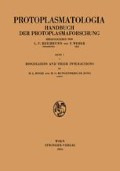Abstract
In chapter 2 we met two types of coacervation, the simple coacervation and the complex coacervation. The latter resembles the salt formation of inorganic chemistry. When we speak of complex-relations, we mean the electrical attraction between oppositely charged groups. Thus a complex-coacervate is a coacervate resulting from the interaction of two oppositely charged components (one at least should be a colloid). Of course, these complex relations may be present in all kinds of colloid systems (one might imagine complex sols, complex gels, complex coacervates, and so on).
Access this chapter
Tax calculation will be finalised at checkout
Purchases are for personal use only
Preview
Unable to display preview. Download preview PDF.
References
Bungenberg de Jong, H. G., 1949: Chapter X in Kruyt’s Colloid Science II, Amsterdam.
— und W. A. L. Dekker, 1935-1936: Complexkoazervation des Systems Gummiarabikum-Gelatine. I. Kolloid-Beih. 43, 143–212; II. Kolloid-Beih. 43, 213-271.
— and J. M. F. Landsmeer, 1946-1947: Changes in diameter of gelated coacervate drops of the complex coacervate Gelatin-Gum arabic, resulting from a change in the pH, or from neutral salts added to the surrounding medium. I. Rec. trav. chim. Pays-Bas 65, 606–613, II. Proc. Kon. Ned. Akad. Wetensch. Amst. 51, 137-144, III. Proc. Kon. Ned. Akad. Wetensch. Amst. 51, 295-301.
Dekker, W. A. L., and C. Van der Meer, 1952: Influence of electric charge and valence of ions on the specific precipitation of diphtheria toxin with antitoxic horse serum. Rec. trav. chim. Pays-Bas 71, 88–100.
Haan, Iz. de 1935: Ionenwirkung und Wasserpermeabilität. Protoplasma 24, 186–197.
Loeven, W. A., 1953: Het complex systeem collageen-mucopolysaccharide in bindweefsel. Thesis, Leiden.
— 1955: The binding collagen-mucopolysaccharide in connective tissue. Acta Anat. 24, 217–244.
— 1955: The nature of the complex binding between collagen and mucopolysaccharide in connective tissue. Acta Physiol. Pharmacol. Neerl. 4, 243–273.
— 1956: The complex binding between protein and mucopolysaccharide in connective tissue. Acta Physiol. Pharmacol. Neerl., in press.
Van der Meer, C. 1946: Complex relations in the 2nd phase of blood coagulation. Proc. Kon. Ned. Akad. Wetensch. Amst. 49, 251–264.
— 1948: Complexbetrekkingen in de tweede phase van de bloedstolling. Thesis, Leiden.
Author information
Authors and Affiliations
Rights and permissions
Copyright information
© 1956 Springer-Verlag in Vienna
About this chapter
Cite this chapter
Booij, H.L., Bungenberg de Jong, H.G. (1956). Complex Systems. In: Biocolloids and their Interactions. Protoplasmatologia, vol 1 / 2. Springer, Vienna. https://doi.org/10.1007/978-3-7091-5456-4_4
Download citation
DOI: https://doi.org/10.1007/978-3-7091-5456-4_4
Publisher Name: Springer, Vienna
Print ISBN: 978-3-211-80421-6
Online ISBN: 978-3-7091-5456-4
eBook Packages: Springer Book Archive

